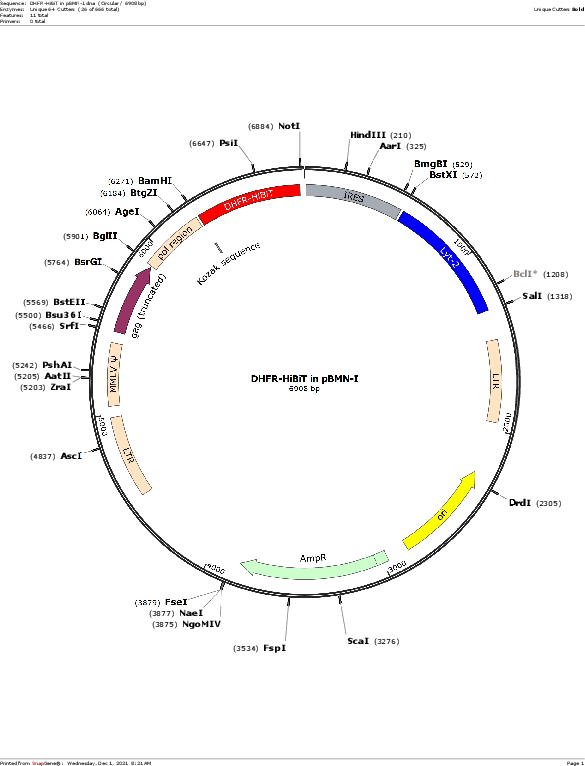pBMN DHFR-HiBiT / Lyt2
(Plasmid
#179731)
-
PurposeExpresses human dihydrofolate reductase (DHFR) with C-terminal HiBiT tag in mammalian cells. This retroviral vector has an IRES-Lyt-2 downstream of the cloning sites
-
Depositing Lab
-
Sequence Information
Ordering
| Item | Catalog # | Description | Quantity | Price (USD) | |
|---|---|---|---|---|---|
| Plasmid | 179731 | Standard format: Plasmid sent in bacteria as agar stab | 1 | $85 | |
Backbone
-
Vector backbonepBMN
-
Backbone manufacturerProf. G. Nolan, Stanford University, Stanford, CA
- Backbone size w/o insert (bp) 6352
- Total vector size (bp) 6952
-
Vector typeRetroviral
Growth in Bacteria
-
Bacterial Resistance(s)Ampicillin, 100 μg/mL
-
Growth Temperature37°C
-
Growth Strain(s)DH5alpha
-
Copy numberHigh Copy
Gene/Insert
-
Gene/Insert namehuman DHFR-HiBiT and IRES-Lyt-2
-
Alt nameDHFR-HiBiT
-
Alt nameDHFR, DHFRP1, DYR
-
SpeciesH. sapiens (human), M. musculus (mouse)
-
Insert Size (bp)600
-
GenBank IDNM_000791
-
Entrez GeneDHFR (a.k.a. DHFR1, DHFRP1, DYR)
- Promoter LTR/MMLV
-
Tag
/ Fusion Protein
- HiBiT (C terminal on insert)
Cloning Information
- Cloning method Restriction Enzyme
- 5′ cloning site BamH1 (not destroyed)
- 3′ cloning site Not1 (not destroyed)
- 5′ sequencing primer pBMN 5’
- 3′ sequencing primer IRES reverse (Common Sequencing Primers)
Terms and Licenses
-
Academic/Nonprofit Terms
-
Industry Terms
- Not Available to Industry
Trademarks:
- Zeocin® is an InvivoGen trademark.
Depositor Comments
The human DHFR-HiBiT fusion protein was constructed to have the HiBiT tag (VSGWRLFKKIS) sequence (Schwinn, MK et al. (2018) ACS Chem. Biol. 13(2): 467–474) located at the C-terminus of DHFR. The human DHFR-HiBiT construct was synthesized (Bio Basic) and cloned into the retroviral vector pBMN IRES-Lyt-2 (G. Nolan, Stanford University, Stanford, CA), which expresses the coding region of mouse CD8a (Lyt-2), using the restriction sites BamH1 / Not1. All constructs were sequenced to validate authenticity. BamH1- GCCACC-ATG-DHFR-HiBiT-Stop –Not1
These plasmids were created by your colleagues. Please acknowledge the Principal Investigator, cite the article in which the plasmids were described, and include Addgene in the Materials and Methods of your future publications.
-
For your Materials & Methods section:
pBMN DHFR-HiBiT / Lyt2 was a gift from James Inglese (Addgene plasmid # 179731 ; http://n2t.net/addgene:179731 ; RRID:Addgene_179731) -
For your References section:
Methotrexate-based PROTACs as DHFR-specific chemical probes. Rana S, Dranchak P, Dahlin JL, Lamy L, Li W, Oliphant E, Shrimp JH, Rajacharya GH, Tharakan R, Holland DO, Whitten AS, Wilson KM, Singh PK, Durum SK, Tao D, Rai G, Inglese J. Cell Chem Biol. 2024 Feb 15;31(2):221-233.e14. doi: 10.1016/j.chembiol.2023.09.014. Epub 2023 Oct 23. 10.1016/j.chembiol.2023.09.014 PubMed 37875111





